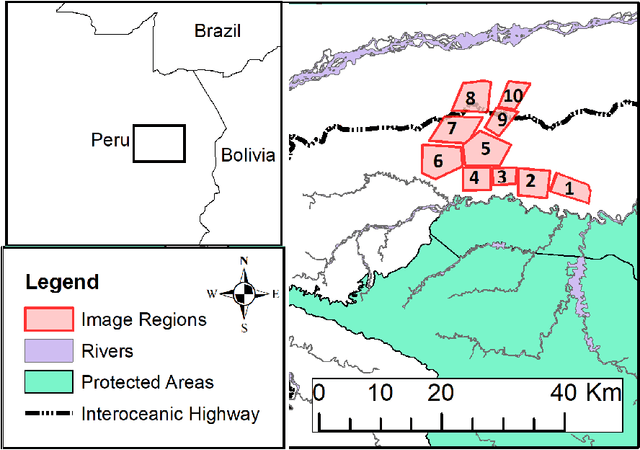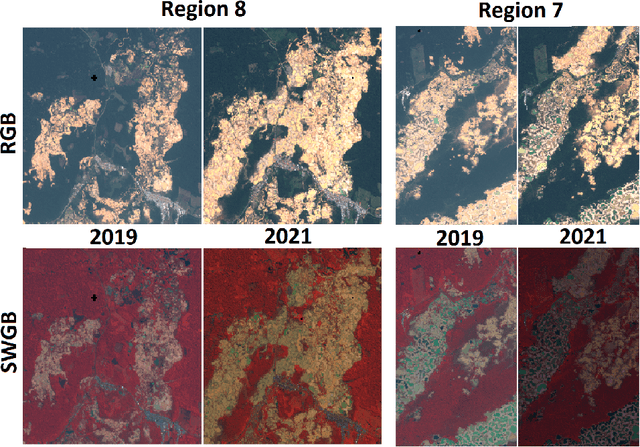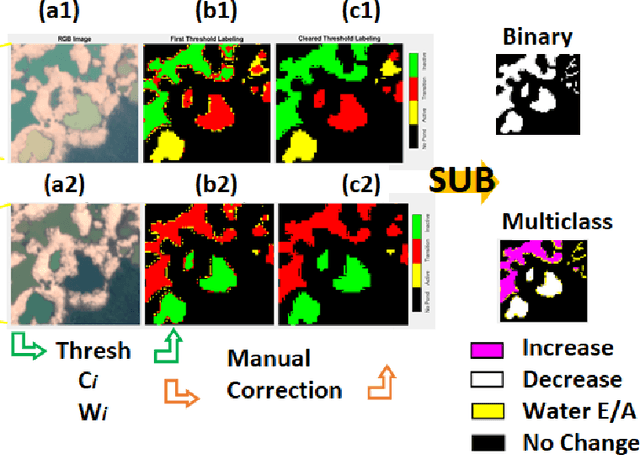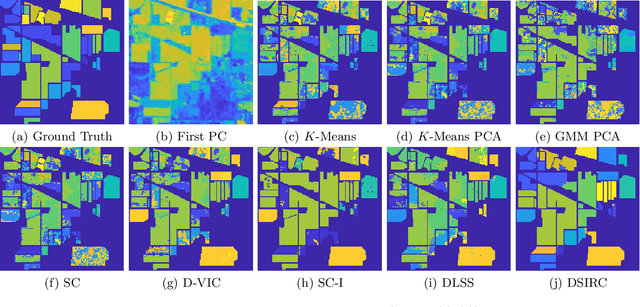Kangning Cui
A Local Perspective-based Model for Overlapping Community Detection
Mar 27, 2025Abstract:Community detection, which identifies densely connected node clusters with sparse between-group links, is vital for analyzing network structure and function in real-world systems. Most existing community detection methods based on GCNs primarily focus on node-level information while overlooking community-level features, leading to performance limitations on large-scale networks. To address this issue, we propose LQ-GCN, an overlapping community detection model from a local community perspective. LQ-GCN employs a Bernoulli-Poisson model to construct a community affiliation matrix and form an end-to-end detection framework. By adopting local modularity as the objective function, the model incorporates local community information to enhance the quality and accuracy of clustering results. Additionally, the conventional GCNs architecture is optimized to improve the model capability in identifying overlapping communities in large-scale networks. Experimental results demonstrate that LQ-GCN achieves up to a 33% improvement in Normalized Mutual Information (NMI) and a 26.3% improvement in Recall compared to baseline models across multiple real-world benchmark datasets.
Detection and Geographic Localization of Natural Objects in the Wild: A Case Study on Palms
Feb 18, 2025Abstract:Palms are ecologically and economically indicators of tropical forest health, biodiversity, and human impact that support local economies and global forest product supply chains. While palm detection in plantations is well-studied, efforts to map naturally occurring palms in dense forests remain limited by overlapping crowns, uneven shading, and heterogeneous landscapes. We develop PRISM (Processing, Inference, Segmentation, and Mapping), a flexible pipeline for detecting and localizing palms in dense tropical forests using large orthomosaic images. Orthomosaics are created from thousands of aerial images and spanning several to hundreds of gigabytes. Our contributions are threefold. First, we construct a large UAV-derived orthomosaic dataset collected across 21 ecologically diverse sites in western Ecuador, annotated with 8,830 bounding boxes and 5,026 palm center points. Second, we evaluate multiple state-of-the-art object detectors based on efficiency and performance, integrating zero-shot SAM 2 as the segmentation backbone, and refining the results for precise geographic mapping. Third, we apply calibration methods to align confidence scores with IoU and explore saliency maps for feature explainability. Though optimized for palms, PRISM is adaptable for identifying other natural objects, such as eastern white pines. Future work will explore transfer learning for lower-resolution datasets (0.5 to 1m).
Bilateral Signal Warping for Left Ventricular Hypertrophy Diagnosis
Nov 13, 2024Abstract:Left Ventricular Hypertrophy (LVH) is a major cardiovascular risk factor, linked to heart failure, arrhythmia, and sudden cardiac death, often resulting from chronic stress like hypertension. Electrocardiography (ECG), while varying in sensitivity, is widely accessible and cost-effective for detecting LVH-related morphological changes. This work introduces a bilateral signal warping (BSW) approach to improve ECG-based LVH diagnosis. Our method creates a library of heartbeat prototypes from patients with consistent ECG patterns. After preprocessing to eliminate baseline wander and detect R peaks, we apply BSW to cluster heartbeats, generating prototypes for both normal and LVH classes. We compare each new record to these references to support diagnosis. Experimental results show promising potential for practical application in clinical settings.
Real-Time Localization and Bimodal Point Pattern Analysis of Palms Using UAV Imagery
Oct 14, 2024



Abstract:Understanding the spatial distribution of palms within tropical forests is essential for effective ecological monitoring, conservation strategies, and the sustainable integration of natural forest products into local and global supply chains. However, the analysis of remotely sensed data in these environments faces significant challenges, such as overlapping palm and tree crowns, uneven shading across the canopy surface, and the heterogeneous nature of the forest landscapes, which often affect the performance of palm detection and segmentation algorithms. To overcome these issues, we introduce PalmDSNet, a deep learning framework for real-time detection, segmentation, and counting of canopy palms. Additionally, we employ a bimodal reproduction algorithm that simulates palm spatial propagation to further enhance the understanding of these point patterns using PalmDSNet's results. We used UAV-captured imagery to create orthomosaics from 21 sites across western Ecuadorian tropical forests, covering a gradient from the everwet Choc\'o forests near Colombia to the drier forests of southwestern Ecuador. Expert annotations were used to create a comprehensive dataset, including 7,356 bounding boxes on image patches and 7,603 palm centers across five orthomosaics, encompassing a total area of 449 hectares. By combining PalmDSNet with the bimodal reproduction algorithm, which optimizes parameters for both local and global spatial variability, we effectively simulate the spatial distribution of palms in diverse and dense tropical environments, validating its utility for advanced applications in tropical forest monitoring and remote sensing analysis.
PalmProbNet: A Probabilistic Approach to Understanding Palm Distributions in Ecuadorian Tropical Forest via Transfer Learning
Mar 05, 2024Abstract:Palms play an outsized role in tropical forests and are important resources for humans and wildlife. A central question in tropical ecosystems is understanding palm distribution and abundance. However, accurately identifying and localizing palms in geospatial imagery presents significant challenges due to dense vegetation, overlapping canopies, and variable lighting conditions in mixed-forest landscapes. Addressing this, we introduce PalmProbNet, a probabilistic approach utilizing transfer learning to analyze high-resolution UAV-derived orthomosaic imagery, enabling the detection of palm trees within the dense canopy of the Ecuadorian Rainforest. This approach represents a substantial advancement in automated palm detection, effectively pinpointing palm presence and locality in mixed tropical rainforests. Our process begins by generating an orthomosaic image from UAV images, from which we extract and label palm and non-palm image patches in two distinct sizes. These patches are then used to train models with an identical architecture, consisting of an unaltered pre-trained ResNet-18 and a Multilayer Perceptron (MLP) with specifically trained parameters. Subsequently, PalmProbNet employs a sliding window technique on the landscape orthomosaic, using both small and large window sizes to generate a probability heatmap. This heatmap effectively visualizes the distribution of palms, showcasing the scalability and adaptability of our approach in various forest densities. Despite the challenging terrain, our method demonstrated remarkable performance, achieving an accuracy of 97.32% and a Cohen's kappa of 94.59% in testing.
Superpixel-based and Spatially-regularized Diffusion Learning for Unsupervised Hyperspectral Image Clustering
Dec 24, 2023Abstract:Hyperspectral images (HSIs) provide exceptional spatial and spectral resolution of a scene, crucial for various remote sensing applications. However, the high dimensionality, presence of noise and outliers, and the need for precise labels of HSIs present significant challenges to HSIs analysis, motivating the development of performant HSI clustering algorithms. This paper introduces a novel unsupervised HSI clustering algorithm, Superpixel-based and Spatially-regularized Diffusion Learning (S2DL), which addresses these challenges by incorporating rich spatial information encoded in HSIs into diffusion geometry-based clustering. S2DL employs the Entropy Rate Superpixel (ERS) segmentation technique to partition an image into superpixels, then constructs a spatially-regularized diffusion graph using the most representative high-density pixels. This approach reduces computational burden while preserving accuracy. Cluster modes, serving as exemplars for underlying cluster structure, are identified as the highest-density pixels farthest in diffusion distance from other highest-density pixels. These modes guide the labeling of the remaining representative pixels from ERS superpixels. Finally, majority voting is applied to the labels assigned within each superpixel to propagate labels to the rest of the image. This spatial-spectral approach simultaneously simplifies graph construction, reduces computational cost, and improves clustering performance. S2DL's performance is illustrated with extensive experiments on three publicly available, real-world HSIs: Indian Pines, Salinas, and Salinas A. Additionally, we apply S2DL to landscape-scale, unsupervised mangrove species mapping in the Mai Po Nature Reserve, Hong Kong, using a Gaofen-5 HSI. The success of S2DL in these diverse numerical experiments indicates its efficacy on a wide range of important unsupervised remote sensing analysis tasks.
A Global and Patch-wise Contrastive Loss for Accurate Automated Exudate Detection
Feb 22, 2023Abstract:Diabetic retinopathy (DR) is a leading cause of blindness worldwide. Early diagnosis is essential in the treatment of diabetes and can assist in preventing vision impairment. Since manual annotation of medical images is time-consuming, costly, and prone to subjectivity that leads to inconsistent diagnoses, several deep learning segmentation approaches have been proposed to address these challenges. However, these networks often rely on simple loss functions, such as binary cross entropy (BCE), which may not be sophisticated enough to effectively segment lesions such as those present in DR. In this paper, we propose a loss function that incorporates a global segmentation loss, a patch-wise density loss, and a patch-wise edge-aware loss to improve the performance of these networks on the detection and segmentation of hard exudates. Comparing our proposed loss function against the BCE loss on several state-of-the-art networks, our experimental results reveal substantial improvement in network performance achieved by incorporating the patch-wise contrastive loss.
Dual-View Selective Instance Segmentation Network for Unstained Live Adherent Cells in Differential Interference Contrast Images
Jan 27, 2023Abstract:Despite recent advances in data-independent and deep-learning algorithms, unstained live adherent cell instance segmentation remains a long-standing challenge in cell image processing. Adherent cells' inherent visual characteristics, such as low contrast structures, fading edges, and irregular morphology, have made it difficult to distinguish from one another, even by human experts, let alone computational methods. In this study, we developed a novel deep-learning algorithm called dual-view selective instance segmentation network (DVSISN) for segmenting unstained adherent cells in differential interference contrast (DIC) images. First, we used a dual-view segmentation (DVS) method with pairs of original and rotated images to predict the bounding box and its corresponding mask for each cell instance. Second, we used a mask selection (MS) method to filter the cell instances predicted by the DVS to keep masks closest to the ground truth only. The developed algorithm was trained and validated on our dataset containing 520 images and 12198 cells. Experimental results demonstrate that our algorithm achieves an AP_segm of 0.555, which remarkably overtakes a benchmark by a margin of 23.6%. This study's success opens up a new possibility of using rotated images as input for better prediction in cell images.
Semi-supervised Change Detection of Small Water Bodies Using RGB and Multispectral Images in Peruvian Rainforests
Jun 19, 2022



Abstract:Artisanal and Small-scale Gold Mining (ASGM) is an important source of income for many households, but it can have large social and environmental effects, especially in rainforests of developing countries. The Sentinel-2 satellites collect multispectral images that can be used for the purpose of detecting changes in water extent and quality which indicates the locations of mining sites. This work focuses on the recognition of ASGM activities in Peruvian Amazon rainforests. We tested several semi-supervised classifiers based on Support Vector Machines (SVMs) to detect the changes of water bodies from 2019 to 2021 in the Madre de Dios region, which is one of the global hotspots of ASGM activities. Experiments show that SVM-based models can achieve reasonable performance for both RGB (using Cohen's $\kappa$ 0.49) and 6-channel images (using Cohen's $\kappa$ 0.71) with very limited annotations. The efficacy of incorporating Lab color space for change detection is analyzed as well.
Unsupervised Spatial-spectral Hyperspectral Image Reconstruction and Clustering with Diffusion Geometry
Apr 28, 2022

Abstract:Hyperspectral images, which store a hundred or more spectral bands of reflectance, have become an important data source in natural and social sciences. Hyperspectral images are often generated in large quantities at a relatively coarse spatial resolution. As such, unsupervised machine learning algorithms incorporating known structure in hyperspectral imagery are needed to analyze these images automatically. This work introduces the Spatial-Spectral Image Reconstruction and Clustering with Diffusion Geometry (DSIRC) algorithm for partitioning highly mixed hyperspectral images. DSIRC reduces measurement noise through a shape-adaptive reconstruction procedure. In particular, for each pixel, DSIRC locates spectrally correlated pixels within a data-adaptive spatial neighborhood and reconstructs that pixel's spectral signature using those of its neighbors. DSIRC then locates high-density, high-purity pixels far in diffusion distance (a data-dependent distance metric) from other high-density, high-purity pixels and treats these as cluster exemplars, giving each a unique label. Non-modal pixels are assigned the label of their diffusion distance-nearest neighbor of higher density and purity that is already labeled. Strong numerical results indicate that incorporating spatial information through image reconstruction substantially improves the performance of pixel-wise clustering.
 Add to Chrome
Add to Chrome Add to Firefox
Add to Firefox Add to Edge
Add to Edge